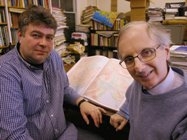Europe's Celtic Roots

Dr Alexander Falilevev and Professor Patrick Simms-Williams
01 February 2008
It is well known that the roots of the Welsh language extend far back into the distant Celtic past, and now scholars from Aberystwyth University's Department of Welsh are preparing to search for the earliest evidence of the Celtic language from which Welsh and the other surviving Celtic languages developed.
In the third in a series of large grants made by the Arts and Humanities Research Council (AHRC) to scholars in the Department of Welsh at Aberystwyth University, a group led by Professor Patrick Sims-Williams has been awarded £390,889 to pursue their studies.
The ancient Celtic language is known from inscriptions in areas of the Continent where writing-systems developed early, starting in north Italy and Switzerland about 2,500 years ago, and then in Spain and France. However the group has used ancient place-names in sources like Ptolemy’s Geography to prove that Celtic was spoken over a much wider area.
More recently they have been searching for Celtic personal names in Roman inscriptions. In 2007 Prof. Sims-Williams published a large collection of these with Dr Marilynne Raybould (a graduate in Latin from Aberystwyth University), while Dr Alexander Falileyev, a scholar from St Petersburg working in the Department, published a detailed study of Celtic names in the Roman province of Dacia, roughly modern Romania.
Professor Sims-Williams welcomed the new grant, which will enable Dr Falileyev to make the first full investigation of the evidence to the south of Romania and as far east as Galatia in Turkey. He explained: ‘We know that these areas were colonized from the third century B.C. onwards by peoples who spoke Celtic languages. During the Roman Empire this early stratum was overlain by further immigration of people with Celtic names, including soldiers and traders. In our new project we will be developing better methods for identifying these names.’
Professor Sims-Williams added that ‘it’s becoming clear that Celtic was one of the major languages of ancient Europe, alongside Greek and Latin, and that’s an exciting perspective for people who tend to think of Celtic languages as minority languages. Somehow this research programme fits in with the fact that students now come from all over the world to Aberystwyth to study Celtic with us. It would appear that most EU countries have a Celtic past!’.
The title of the project funded by the AHRC is ‘Gaulish morphology with particular reference to areas south and east of the Danube’
Professor Patrick Sims-Williams
Patrick Sims-Williams, MA (Cantab.), PhD (Birmingham), FBA is Professor of Celtic Studies at the Department of Welsh, Aberystwyth University. His academic interests include early Irish and Welsh language and literature, comparative Celtic philology, early medieval insular history. Professor Sims-Williams is editor of Cambrian Medieval Celtic Studies.
Recent publications
‘Person-Switching in Celtic Panegyric: Figure or Fault?’, CSANA Year-Book, 3/4 (2005), 315-26.
‘Medieval Irish Literary Theory and Criticism: 1. Poetic Theory’, The Cambridge History of Literary Criticism, II, The Middle Ages, gol. Alastair Minnis & Ian Johnson (Cambridge: Cambridge University Press, 2005), tt. 291-301 & 754-58.
‘A Recension of Boniface’s Letter to Eadburg about the Monk of Wenlock’s Vision’, Latin Learning and English Lore, I, gol. Katherine O’Brien O’Keeffe & Andy Orchard (Toronto: University of Toronto Press, 2005), tt. 194-214.
New Approaches to Celtic Place-Names in Ptolemy’s Geography, gol. Javier de Hoz, Eugenio R. Luján, & Patrick Sims-Williams (Madrid: Ediciones Clásicas, 2005), 287tt.
The Iron House in Ireland, H. M. Chadwick Memorial Lectures, 16 (Cambridge, 2006), 31tt.
Ancient Celtic Place-Names in Europe and Asia Minor, Publications of the Philological Society, 39 (Oxford, 2006), xiii + 406tt., 69 o fapiau.
The Geography of Celtic Personal Names in the Latin Inscriptions of the Roman Empire (Aberystwyth: CMCS, 2007), iv + 210 tt. (gyda Marilynne E. Raybould)
A Corpus of Latin Inscriptions of the Roman Empire Containing Celtic Personal Names (Aberystwyth: CMCS, 2007), ix + 283 tt. (gyda Marilynne E. Raybould)
‘Common Celtic, Gallo-Brittonic and Insular Celtic’, Gaulois et Celtique Continental, gol. Pierre-Yves Lambert & Georges-Jean Pinault (Geneva: Droz, 2007), tt. 309-54.
Studies on Celtic Languages before the Year 1000 (Aberystwyth: CMCS, 2007), ix + 253 tt.
The Department of Welsh
http://www.aber.ac.uk/cymraeg-welsh/intro.shtml
The Department is of international renown, whose quality of teaching and research has been recognized by the Higher Education Funding Council. In the most recent teaching quality exercise the Welsh Department was assessed as being 'Excellent'. In the 2001 Research Assessment Exercise the Department was awarded a 5*A, the highest possible grade, attained by only three other Departments within its field within the whole of the UK.
The Arts and Humanities Research Council
Arts and Humanities Research Council - Each year the AHRC provides approximately £90 million from the Government to support research and postgraduate study in the arts and humanities, from archaeology and English literature to design and dance. In any one year, the AHRC makes approximately 700 research awards and around 1,500 postgraduate awards. Awards are made after a rigorous peer review process, to ensure that only applications of the highest quality are funded. Arts and humanities researchers constitute nearly a quarter of all research-active staff in the higher education sector. The quality and range of research supported by this investment of public funds not only provides social and cultural benefits but also contributes to the economic success of the UK.
Further information is available online at www.ahrc.ac.uk



